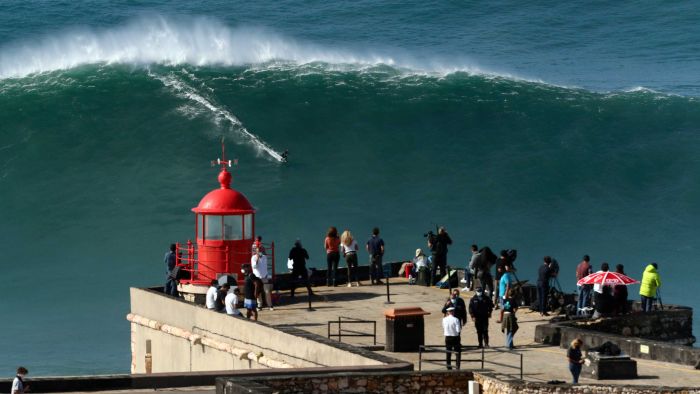This week medical officials in Portugal descended on a beach called Praia do Norte banning spectators and surfers who had arrived to see some of the biggest waves ever ridden at a beach break known as Nazare.
Nazare is notorious.
It has overtaken Hawaii’s Waimea Bay as the place where boys become men and girls become women in the sport of big wave surfing, as mother nature and geographical anomalies throw up winter swells approaching 100 feet (30.5 metres).
Australian surf movie director, Tim Bonython, would normally have been there, but with COVID-19 restrictions in Australia keeping him stuck at home, what initially caused him to melt down has become a “blessing in disguise”.
He has used the time to edit together a series of new surf movies, and as cinemas around the country reopen, his new collection fills a void.
Loading
“Normally I am always racing out of the door chasing swell routes and all the time I am looking at what’s going on with world charts in relation to storms,” Bonython told The Ticket.
“Storms make surf and then you’ve got to join all the dots together … you’ve got to make sure that when the swell hits the spot that you might be looking at, that the winds are nice and the weather is probably OK.
“Once you’ve got that going on you connect with the surfers and you just go.
“Obviously with COVID the way it’s been, it sort of stopped me from travelling.
Inevitably, Nazare features. It is not possible to have a big wave film that doesn’t include Nazare.

As Augusta National is to golf, or Wimbledon is to tennis, so is Nazare to big wave riding. You haven’t made it if you haven’t succeeded there.
“In Australia, we had big waves out to sea. We could see them out there, but no-one really could deal with it because you’d be having to paddle out there [and] you’d be dealing with sharks, so they were never really touched.
“Once these jet skis made these more amazingly unique places part of the sport, then we were looking outside the boundaries.
“Tahiti became a place where you could tow into a monster wave and get the biggest barrel on the planet and then Jaws [in Hawaii] became a place.
“You would tow into monster waves and I’ve documented a movie back in the day called Biggest Wednesday where the waves were 50 to 60 feet. You can’t paddle into those kinds of waves. They move so quickly.
“And now we’ve been looking outside Hawaii … we’ve been going to Europe and we’ve discovered all these amazing big wave locations and we discovered this wave called Nazare.”
Loading
What makes Nazare unique is an underwater canyon that catches the swell travelling across the Atlantic and makes it three times its original size.
“It’s happening right now. We’ve just had a swell in Europe about two weeks ago. Some of the biggest waves hit Nazare and a bunch of other spots and these waves are incredibly dangerous.”
Bonython says the sport has become more viable as the athletes have become more safety aware, using inflatable vests and having “security teams” on jet skis standing by to get surfers out of danger zones.
“But they’re used to the power, they train for it, they’ve got the safety and now they’re ready to challenge themselves in the world’s biggest waves.”
Back in the 1980s a precocious young beach lover from Adelaide convinced a surf shop owner in Sydney to sponsor him on a trip to Victoria’s Bell’s Beach to film the annual Easter Classic surf contest.
“It was like 15 to 20 foot,” Bonython remembers.
“Simon Anderson brought out a three-fin board … and went out there and ripped Bells Beach to shreds and I had my super eight movie camera and documented every bit of it.
“I went back to Adelaide and edited the super eight film together and we had a show at the local pub … I had a line a mile long down the street trying to buy a ticket to come and see the film.”
Dealing with fear the key for surfers
Bonython’s passion became his profession, much like the big wave riders themselves.




“To this day, you can get any person off the street … and they’ll just go, ‘That’s amazing [when they see big wave riding],'” he said.
“To see the way these surfers deal with mother nature, it is all about just getting used to the fear — and that’s what would kill a normal person in waves of consequence.
“Even like a two to three-foot wave down in Coogee, if you’re dealing with mother nature and its sucking you out to sea, you are going to go to panic level.
“That’s what I’ve done all my life and it really is a challenge but it’s super exciting and that’s why I call it the best job on the planet.”
The Australian Surf Movie Festival national tour begins on November 9. The full festival schedule is available here.







